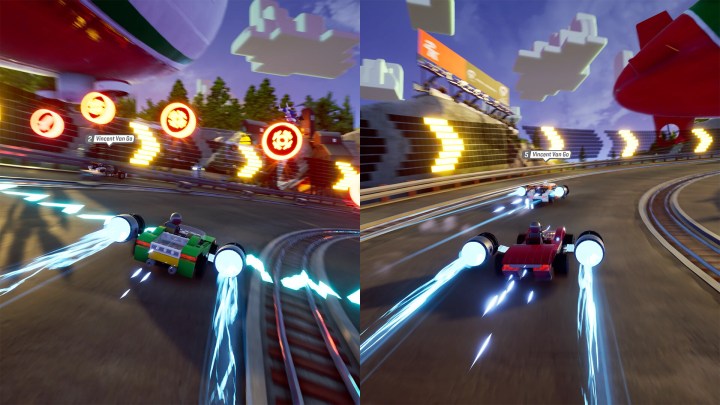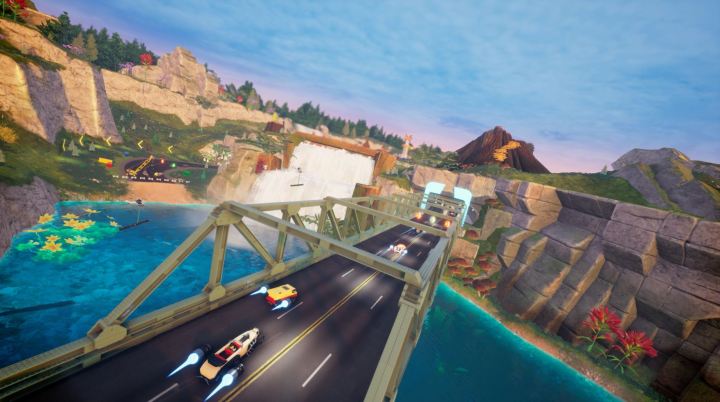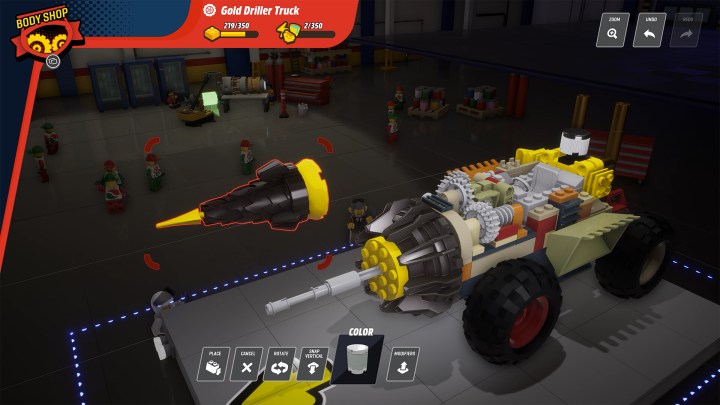“Lego 2K Drive's chaotic racing and inventive story mode are let down by irresponsible microtransactions.”
- Fast-paced racing fun
- Excellent Lego aesthetics
- Standout story mode
- Deep kart creation suite
- Some dud minigames
- Egregious monetization
- Unclear progression
Lego 2K Drive accomplishes something that I was beginning to think wasn’t possible: It pushes the kart racer genre forward in a post-Mario Kart 8 world.
For the past decade, Nintendo’s sales behemoth has felt like the final endgame for casual racing games. While titles like Team Sonic Racing and Disney Speedstorm would provide fun versions of Mario Kart’s formula, they were iterations that couldn’t surpass their inspiration. Lego 2K Drive, on the other hand, breaks away from the pack to chase its own imaginative vision of the kart racer’s future. It pulls from the Forza Horizon series to create an imaginative kart racer that should have the Mario Kart team taking notes — both on what works and what very much doesn’t.
Lego 2K Drive is a chaotically fun kart racer with a standout single-player mode that I hope to see become a new standard for the genre. It’s just a shame that it’s saddled with some egregious microtransactions that should raise red flags for parents and competitive players looking to race online.
Brick-breaking speed
When it comes to the fundamentals of a good kart racer, Lego 2K Drive fires on all cylinders. It’s a fast-paced racing game that combines Mario Kart’s tried and true driving mechanics with some of its own. There are items like homing rockets that’ll blow other drivers’ Lego cars to smithereens, and an emphasis on drifting that gives players a lot of control over their turns. It’s a fast, loud, and forgiving driving formula that’s particularly well-built for young kids or casual party-goers alike.
It really captures the gleeful energy of a kid smashing their creations together.
Chaos is the name of the game here and that’s where Lego 2K Drive truly breaks away from the pack. Where most racers penalize players for driving off-road or crashing into objects, 2K Drive both encourages and rewards those acts. Smashing items fills up a long boost meter that can be drained at any time. That makes reckless driving an appealing option, as skilled players can use destruction to their advantage to keep their momentum up at all times. It’s an inversion of the usual racing game rulebook and one that fits the nature of the Lego brand. It really captures the gleeful energy of a kid smashing their creations together.
That formula is further twisted by the fact that players have a street racing car, an off-road vehicle, and a boat equipped at all times. The car seamlessly transforms during a race depending on what terrain it’s on, something its 20+ tracks fully take advantage of. Some of the best maps have me driving tight turns on land before plunging into a wide-open swamp and launching off of ramps like I’ve just dropped into a jet ski game. Each track is intricately crafted and filled to the brim with shortcuts that can be accessed with smart boost management and well-timed kart hopping.

What makes all of that work so well is the fact that developer Visual Concepts has a field day in bringing the imaginative world of Lego to life. It’s always a blast to see muscle cars going head to head with giant hamburgers, as they smash through scenery made out of Lego and blast it into hundreds of colorful pieces. It’s everything I could want from that toybox-like experience, complete with the satisfying sounds of blocks clattering around as I zip through tracks.
It may not be the deepest racing game, but that works in its favor. Just as the toys themselves transcend age, I can see both adults and kids getting a kick out of the cheery, bombastic racer. It doesn’t require too much skill, instead focusing on how well players can navigate around chaos … or use it to their advantage.
Forza for kids
Though there are standard multiplayer racing modes here, both local and online, the real star of the show is its delightful single-player story mode. Taking design cues from Forza Horizon, players are dropped into four open-world biomes that are filled with races and optional side missions. The presentation of it all shines as it’s filled with stop-motion-like cinematics and legitimately funny kid’s humor that makes it feel like an adaptation of The Lego Movie. It’s the exact tone I’ve always wanted from a Lego video game.

Each environment brings its own distinct charm to the adventure. Big Butte County is filled with canyons that I can launch over, as well as prospector-themed towns that give it an Old-West vibe. Hauntsborough, on the other hand, is a spooky location that takes me through winding swamps. Each world feels like its own Lego set assembled into a racer’s paradise. And it’s especially impressive that Visual Concepts has naturally layered intricate race tracks inside each zone.
The Forza formula winds up being a perfect match for a sub-genre that’s gotten a bit stale over the years. The world of Bricklandia is filled with things to do between races, from a wealth of collectibles to hunt down to short challenges that can be seamlessly triggered without jumping into a loading screen. When I drive through a gate in a canyon, I suddenly find myself trying to complete laps around a short, dusty trail littered with mines. Another has me suddenly trying to drive my car up a twisting garden hose without falling off. Each challenge gives players a chance to test their skills outside of a two to three-minute race, breaking up a kart racing formula that’s been stagnant since the genre’s inception.
I couldn’t help but wish Nintendo would adopt the ideas here for Mario Kart 9.
Not every idea is a winner. Some frustrating story missions have me trying to save Bricklandia residents from killer clowns and cowboys, struggling to use driving mechanics built for speed for slow escort objectives (a weak minigame mode breaks out its worst missions into standalone score runs). Even so, those diversions weren’t enough to spoil my fun. There’s always something to do or discover in Bricklandia and I felt compelled to scour the world for secrets. After 10 hours, I’d only completed 20% of the overall map.
Playing through the story mode, I couldn’t help but wish Nintendo would adopt the ideas here for Mario Kart 9. I’d love to see the series’ excellent tracks linked together into a grand overworld that can be fully explored. Lego 2K Drive makes a strong case for the kart racing genre to explore that premise further, giving games like this more life for solo players who want a good reason to drift around even when their friends are busy.
Beware of microtransactions
There’s so much that I love about Lego 2K Drive … and that’s what makes its fatal flaw so heartbreaking. The aggressive use of microtransactions here feels, frankly, unconscionable. And for the record, I’m not usually one to complain too much about game monetization. It doesn’t bother me much in a free game like Fortnite, especially since skins don’t have an impact on the battle royale. I don’t even really care about seeing them in other 2K titles like WWE 2K23, as they’re usually geared toward older audiences who are free to make responsible decisions. Hell, even Diablo Immortal didn’t send me into a panic. Even with that wiggle room, there’s something that especially rubs me the wrong way here.
I dread playing this online against racers who’ve ponied up.
Part of the problem is that this is a full-priced game that already has monetization in the form of paid season passes. The added online shop full of Lego pieces, characters, and cars just winds up feeling greedy — especially considering the prices needed to buy things. After 10 hours in the campaign, I’d earned around $500 in Brickbux that could be spent in the online shop. That wasn’t enough to get me anything, as even a decal would cost $1000. The season pass would get me 550 studs that I could convert to Brickbux, but that was only enough to buy me a single car … and leave me with 50 studs that I couldn’t do much with, tempting me to spend more so I could convert them.
(Note: 2K Games has since increased the payout for Brickbux in story mode, which should alleviate some of the pain points I mentioned here. I’m hopeful that the publisher will continue to tweak its microtransaction system with player feedback, though my wider critique of their inclusion and implementation in a full retail kid’s game still stands.)
There are parts of the system I don’t mind. Cosmetic decals and racers that have no impact on the game don’t bother me much. I don’t even mind the fact that you can spend money on individual Lego pieces that can be used in the game’s excellent kart customization tool. It’s an annoying charge, but the base game gives you plenty of pieces to toy around with and make some goofy vehicles.

What feels really off, though, is the fact that each purchasable car has stats and sometimes vehicle-specific perks. It doesn’t help that the stats themselves are entirely unclear. I have no idea what the numbers really mean or how impactful they are. That’s an issue that’s even present in the story mode, as I can never really tell if I’m amassing power every time I level up or obtain a new car. That creates an uneasy pay-to-win dynamic, but one that I don’t actually understand enough to make informed purchases. I dread playing this online against racers who’ve ponied up.
These things might not bother me so much if Lego 2K Drive wasn’t explicitly a game aimed at kids. It feels irresponsible to include the kind of paid content you’d find in the NBA 2K series in a cute, casual racing game that’s quite literally filled with shiny toys. You could make the argument that it’s simply a reflection of how Lego works in real life, forcing fans to buy pricey new sets, but at least those are tangible objects whose pieces can be reused. It simply doesn’t feel in line with the good-natured spirit of the game, leaving me to feel a little bad for the developers who created something special that’s been drowned out by what I can only imagine are tone-deaf corporate mandates.
If you steer clear of the shop and online modes, there’s so much to enjoy in Lego 2K Drive. The colorful story mode alone is worth the price of admission, creating a version of Forza Horizon that’s much more welcoming to younger audiences and casual racing fans. It makes me feel like a kid again, playing with Legos in my bedroom. But every time I exit back to the main menu and see the shop, I snap back to being a world-weary adult who can’t help but be critical of unsettling business practices.
Lego 2K Drive was tested on an Xbox Series X hooked up to a TCL 6-Series R635.




